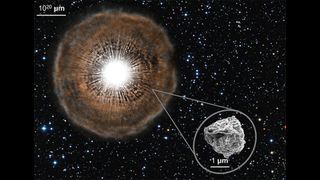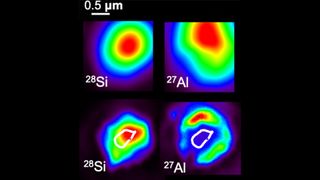Ancient meteorites preserve building blocks of early solar system
Some meteorites contain grains older than the solar system.

Scientists are shedding light on the mysterious origins of ancient meteorite grains using a new analysis method.
These grains, which are older than the solar system itself, formed in ancient stars that died before our sun's birth. Similar stars still exist in the universe and the analysis of these presolar grains provides an interesting glimpse into the stars' chemistry.
Scientists have tried to analyze presolar grains in meteorites before, but Nan Liu, a research assistant professor of physics at Washington University in Missouri and lead author of a new study, believes that earlier methods of studying these grains have been too inaccurate.
Liu and her team analyzed samples of the Murchinson meteorites, which showered 220 lbs. (100 kilograms) of cosmic rock onto the Australian town of Murchinson in 1969. Scientists who previously studied these meteorites quickly realized that this meteoric rain was a lucky strike, and not only because one of the largest pieces broke through the roof of a local barn somehow without injuring anyone.
Related: Blue meteorite crystals reveal the sun's wild youth
"Murchinson is a primitive meteorite, which has formed at the beginning of the solar system and after its formation never melted," Liu told Space.com. "Most meteorites that come from the asteroid belt experience collisions and heating, which melts them so any pristine material from the early stages of the solar system disappears."
In the Murchinson meteorite, grains of rock older than the solar system are embedded in younger material. Scientists know from previous research that these grains pre-date the birth of the solar system because their chemical composition is different.
Get the Space.com Newsletter
Breaking space news, the latest updates on rocket launches, skywatching events and more!
"These grains are made of silicon carbide, that is silicon and carbon atoms," Liu said. "But silicon carbide doesn't naturally form in our solar system because we have a lot of oxygen around and all these carbon atoms would bond with oxygen first to form carbon oxide molecules."
The most likely origin of these grains are the carbon stars, bright red giant stars whose atmospheres contain more carbon than oxygen, Liu said. To confirm this theory, scientists need to find whether the compositions of certain isotopes in the meteoric grains match those in the carbon stars. Isotopes are varieties of the same chemical element that differ by the number of neutrons in their nucleus. While some isotope compositions are common in the solar system, others can only arise inside of specific types of stars.

"The isotopic ratios of these grains are very different from what we see in the solar system," Liu said. "For example, in objects in the solar system, we can see rations of carbon 12 to carbon 13 of about 89. But these presolar grains have carbon 12 to carbon 13 ratios ranging from 2 to 200, which results from fusion reactions in their parent stars."
The same applies for isotopes of nitrogen, aluminum and magnesium.
Astronomers were especially interested whether the isotopic compositions found in these grains matched what observations revealed about carbon stars. But prior to Liu's study, the match was not convincing. One reason could be that these stars, in fact, were not the birthplace of these grains, Liu said. However, she wondered whether the explanation could be much simpler.
"The past measurements were showing much lower carbon and nitrogen isotope ratios in those grains," Liu said. "But I thought that the problem may be in the analytical method. These grains spent hundreds of million years in the interstellar medium, and billions of years in our solar system and as a result their surfaces may have absorbed these materials."
That would mean that in previous studies, scientists may have measured the younger impurities on the surface rather than the presolar grains themselves.
Liu and her team therefore devised a new analytical method designed to remove any material that may cling to the surface of these grains. As part of this technique, they first dissolved pieces of the Murchinson meteorite in acid until they were left only with the silicon carbide grains. They then showered the grains with beams of cesium and oxygen ions to get rid of any material that may have come from younger components of the meteorite.
After all this, the team made spectroscopic measurements of the grains' isotope compositions. The results matched much more closely the data from carbon star observations, Liu said. This confirmed Liu's original suspicion and showed that not only did these grains most likely come from carbon stars but also that they can now be used to help scientists advance their understanding of these types of stars.
"The new isotopic data obtained in this study are exciting for stellar physicists and nuclear astrophysicists like me," Maurizio Busso, a co-author from the University of Perugia, in Italy, said in a statement. "Indeed, the 'strange' nitrogen isotopic ratios of presolar silicon carbide grains have been in the last two decades a remarkable source of concern. The new data explain the difference between what was originally present in the presolar stardust grains and what was attached later, thus solving a long-standing puzzle in the community."
This new data, for example, provides clues as to how carbon stars produce aluminum in their cores, according to Liu. These insights, however, would have to be verified by further research, she added.
The study was published in the journal Astrophysical Journal Letters on Tuesday (Oct. 12).
Follow Tereza Pultarova on Twitter @TerezaPultarova. Follow us on Twitter @Spacedotcom and on Facebook.
Join our Space Forums to keep talking space on the latest missions, night sky and more! And if you have a news tip, correction or comment, let us know at: community@space.com.

Tereza is a London-based science and technology journalist, aspiring fiction writer and amateur gymnast. Originally from Prague, the Czech Republic, she spent the first seven years of her career working as a reporter, script-writer and presenter for various TV programmes of the Czech Public Service Television. She later took a career break to pursue further education and added a Master's in Science from the International Space University, France, to her Bachelor's in Journalism and Master's in Cultural Anthropology from Prague's Charles University. She worked as a reporter at the Engineering and Technology magazine, freelanced for a range of publications including Live Science, Space.com, Professional Engineering, Via Satellite and Space News and served as a maternity cover science editor at the European Space Agency.
